I was given some silk cocoons last year (September of 2019) when I was in North Cyprus. They are local to Cyprus and working with silk and cocoons is a craft tradition there where they are used to make floral decorations (Karlitaş 2015). They come in a range of shades from white to a gold honey colour. My interest was piqued when I was told that there was evidence of a silk industry in Cyprus dating back to the Bronze Age (2000 BC) (Panagiotakopoulou et al 1997; Belgiorno 2010; Gonzato and Lentini 2010; Gonzato 2015; Hadjikyriakos and Trentin 2015; Whitfield 2018). Silk production was written about by both Aristotle (Historia Animalia V: 19.6) and Pliny (Historia Naturalis XI: 75-8). Silk garments were noted by Horace along with images of silk production (Horace Satires I, II: 101-2; Ovid Ars Amatoria II: 298)
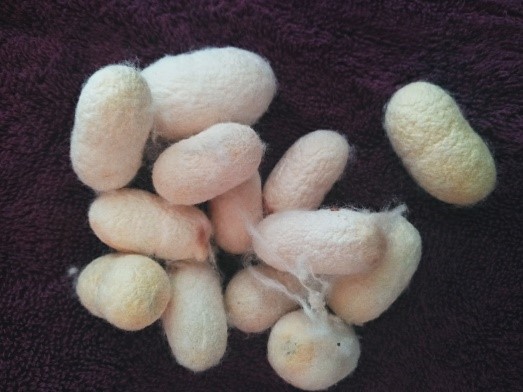
I had never spun silk before, so before I could experiment with the cocoons I needed to gain some proficiency in the craft. I bought some mulberry silk sliver and some silk hankies with the idea that I would work my way up to processing and spinning the silk from the cocoons I was given. I started with the silk sliver.
Spinning Silk Sliver
Mulberry silk is the product of the cultivation in which captive silkworms are fed fresh mulberry leaves. All but a few of the silkworms are killed while they are inside the cocoon in order to have continuous strands of silk (Konstantinou 2016). Sliver is similar to combed wool in that it is a bundle of fibres that have all been aligned. I was told that the best way was to spin from the fold, and I learned immediately that this was true. Unlike wool, silk is slippery. Trying to spin the ends of the fibre led to a lot of frustration, the fibres slipped too quickly between my fingers. By making a loop over my index finger and then spinning from the middle of the strands, I was better able to control the flow of silk to the spindle. This resulted in the fibres wrapping around each other to produce a fine, strong single strand.
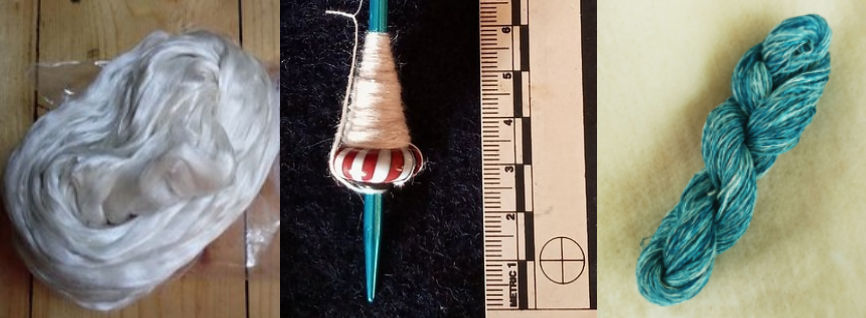
I started with a small supported spindle that was made from a glass bead that weighed 9.8 grams (fig 1b). I’d heard that silk sticks to everything, so I figured that my rough ceramic spindles would catch too much. The small spindle worked well, but I wanted to go faster, so I transferred it to a larger drop spindle made from polyform resin that weighed 24 grams. This worked very well. The sliver is smooth and goes quickly without catching on anything. The sliver was later dyed with indigo using the shibori technique and then chain plied, a technique that combines overlaps the strand into three to make a thicker yarn (figure 1c).
Spinning Silk Hankies or Mawata
Once the 250 grams of sliver was spun, I felt confident to move on to the next step, silk hankies. These are a step closer to cocoons. A silk hankie is an individual degummed cocoon that was stretched on a square frame. Hankie are sold in bundles that resemble layered mats that have a slightly thicker border. I carefully chose an edge of the bundle and gently peeled one layer away. The layer is uneven, so I spent a little time pulling and teasing the edges and any thick spots in the centre. The thick spots tend to be silk from the inner cocoon that has shorter fibers, so I was careful not to tear holes by stretching these too far. Often the shorter fibers are discarded, although some people include them in their spun yarn. The resulting lumps in the yarn are called neps and give an artistic texture to the finished product. To begin spinning, some people pull a thread from the center of the hankie, others from an edge. I find starting with a corner works best while I drape the rest of the hankie over my wrist or wind on a short hand distaff. I found that I had more neps using the hankies than I did with the sliver, but I expect these might wash out since they are probably the shorter fibres from the center of the cocoon. Some of the individual strands of the silk clung to my hand, but it wasn’t nearly as bad as I thought that it would be. I have rough hands, but it didn’t seem to cause any frustration.
The resulting fibre was somewhat finer than when I spun the sliver, although that might be due to my skill improving rather than the different type of processing.
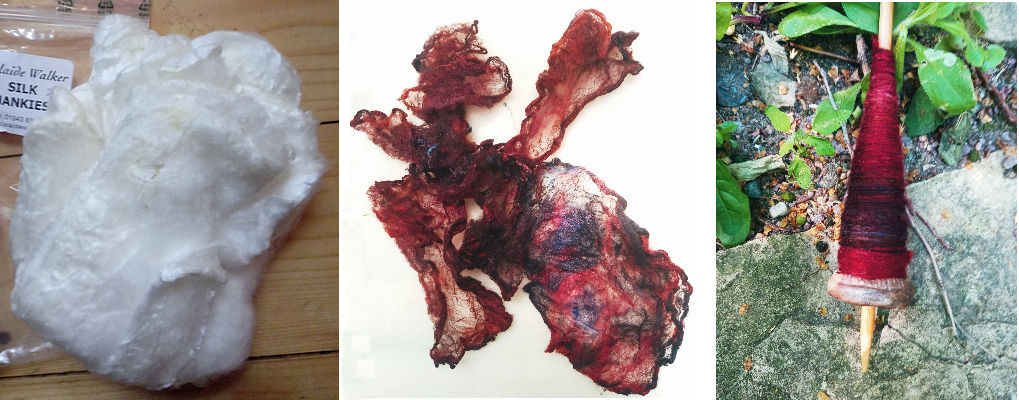
Spinning Degummed Cocoons
For this project I bought commercially degummed cocoons, some of which I dyed using indigo. To spin them, I took an undyed cocoon and pulled and teased it out so it was fairly fluffy and evenly dense. I pulled and twisted some fine strands and put them on the spindle. It spins very fine, and feels more like spinning sliver than hankies. It’s easy to see the structure of the cocoon now and how the inner layers have shorter fibres. Those are like a clump in the middle that have to be carefully teased out. The silk was spun on a replica ceramic Bronze Age spindle weighing 34 grams. Because the cocoons were dyed whole, the centres had less dye than the exterior of the cocoon, giving it a variegated colour.

At this point I felt confident in my spinning ability and began to research the degumming process.
Degumming Cocoons
The cocoons must be degummed before they can be spun. The gum is called sericin, a sticky secretion of the silkworms that holds the cocoon together. Without degumming the fibers tend to cling together, making for an uneven, brittle strands. The process calls for soaking the cocoons in a heated base solution that dissolves the sericin. In order to replicate early silk production, I wanted to make my own alkali solution from wood ash and distilled water.
Making the Alkali Solution
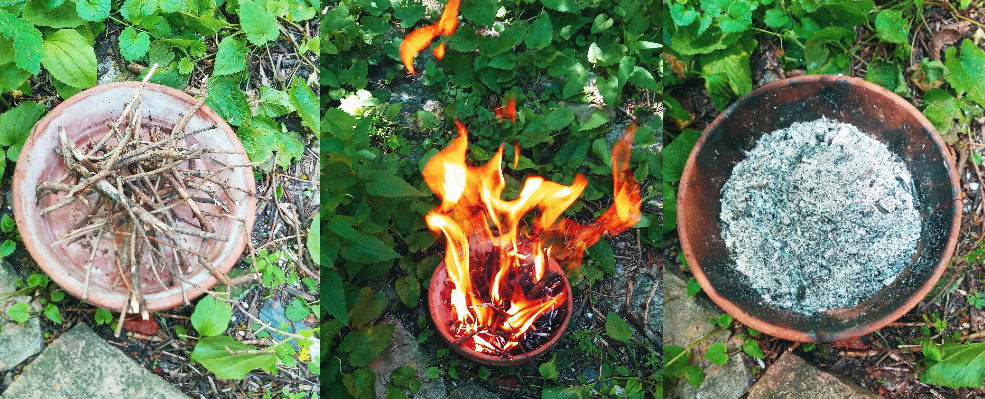
Twigs of lilac and mulberry were burnt in a clean ceramic dish. When cooled, there were 12.2 grams of ash. Any remaining bits of burnt wood were removed.
The ash (12.2 grams) were added to ½ liter of distilled water in a covered ceramic crock and allowed to sit for 24 hours. The solution was filtered through paper filters, after which a reading of pH 11.1 was taken with a calibrated digital pH meter. This is similar in scale to commercial ammonia which ranges from 10.5-11.5. Information for degumming cocoons have suggested using urea or various recipes of soap, lye, washing soda, and baking soda to arrive at the needed alkalinity (Lamb 2014; Cook 2017; Cao et al 2018; Baro 2020). Cao et al (2018) state that silk cocoons are best degummed at a pH of 11.5 in commercial processing, although they found that a pH of 11.0 removed 23% of the sericin, and at 11.5 it increased to 26%. A pH of 11.5 is sufficient to remove the sericin from the interior of an intact cocoon. However, since I had not planned to reel the cocoons, a process for which the cocoons need to be processed whole, the solution of pH 11.1 should be able to penetrate throughout the cocoon. It should be noted that a pH that is too high can damage the proteins of the silk strands, resulting in a weakened fibre (Babu 2019).
The Degumming Process
When silk is reeled, that is when a single continuous strand is pulled from a cocoon, it is important that the silkworm pupa remain inside the cocoon. When the silkworm emerges as a moth, it creates a hole in the end of the cocoon. Likewise, a hole is made if the pupa is removed before processing the cocoon. The degumming process loosens the fibers and creates a wet, messy mass. Even the degummed cocoons that I bought looked like a tangled mess. I decided that picking out bits of bug from a wet pile of cocoons would not be much fun, and because I was more interested in spinning the silk than reeling, I removed the pupae prior to degumming. Some of the cocoons had a weak spot where the cocoon wasn’t as firm. I was able to use the tip of a knife to tease the silk fibers away to create a hole and shake the remains of the pupa out. While I could pull away some of the fibers on those cocoons, the silk was almost brittle and I could see how trying to pull fibers from a cocoon without degumming would be unsuccessful for producing any silk fiber. Other cocoons were firm, about the consistency of cardstock. For those I ended up cutting into the cocoon. I had seen some in this batch where a round hole had been sliced through one end of the cocoon, and I did the same. I’ve learned in conversation with others that the silk can be loosened by boiling, and the silkworm pupae released. In this way the pupae can be used as food, but boiling does not affect the sericin and as soon as the cocoons dry, they turn into a stiff, papery mat.
The recommended process is to heat the cocoons in the alkali solution for a period of time. Baro (2020) recommends bringing the solution and cocoons nearly to a boil and then reduce the heat to a simmer for 10 minutes. Others (Lamb 2014, Luong et al 2015, Cook 2017, Cao et al 2018) all recommend simmering for 30 minutes. Luong et al recommend a temperature of 90°C, while Cao et al recommend 98°C.
Eighteen cocoons were put into the prepared alkali solution in a nonreactive enamelled pot. Since the cocoons were opened, there should be no trouble with the solution being able to wet every surface. The cocoons were brought to a boil in less than five minutes and then the heat was reduced to 90°C and held at that temperature for 30 minutes. Despite pushing them down, the cocoons floated. After about 15 minutes they began to get soggy and limp, but never seemed to lose their structure. Cook (2017) describes the sericin becoming slimy as it dissolves and the silk loosens.
Afterwards the cocoons were rinsed repeatedly in distilled water to remove all traces of sericin and alkali solution. There was no feeling of sliminess and it was very easy to pull fibres from the damp cocoons. It was noted that before degumming the cocoons ranged from white to pale gold colours. After degumming the colours ranged from distinct yellows to greyish olive colours. As they dried the grey ones became more white while the yellow became more intense. It was fairly easy to pull the fibres of the damp cocoons apart, but when dry the fibbers held together, with an almost paper-like texture. Some fibres had a sicky feel to them, By the time all the silk was dried, the fibre was stiff, so it was determined that not all of the sericin had dissolved. There are three variables that could be responsible. 1) that the alkali solution was not string enough. 2) that there wasn’t enough of the solution for the number of cocoons immersed. 3) The cocoons weren’t simmered long enough or the temperature wasn’t high enough.
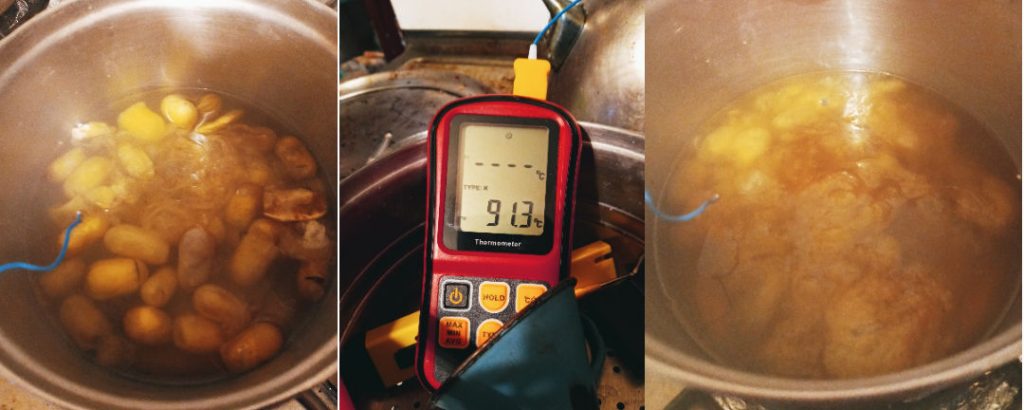
More ash was burned and the charcoal was again filtered out. 34.5 g of ash were added to 1 liter of distilled water. Again, 18 cocoons weighing 5 grams were prepared and were put into a stainless steel pot with the alkali solution. This time the alkali solution had a pH of 11.7. Distilled water (350 ml) was added, but it brought the pH down to 10.5. More ash was burned and added to fresh distilled water and the pH was adjusted to 11.5 using a combination of the fresh solution and the solution with the lower pH. The cocoons were brought to 98C and then the temperature was lowered to 90C. The cocoons were allowed to simmer for 30 minutes. A single cocoon was removed for testing. It was rinsed and quickly dried with paper towelling. The silk was pliable and not sticky. The rest of the cocoons were removed from the alkali bath and then soaked and rinsed repeatedly to remove any remaining sericin.
Spinning the Degummed Cocoons
Once dried, the cocoons provided for a very fine spin using a wooden supported spindle. The fibres are pliable and none of the sericin remains. However, the fibre is fuzzy, almost wooly. It is likely due to cutting holes in the cocoons to remove the silkworms , leaving a large percentage of shorter fibers.
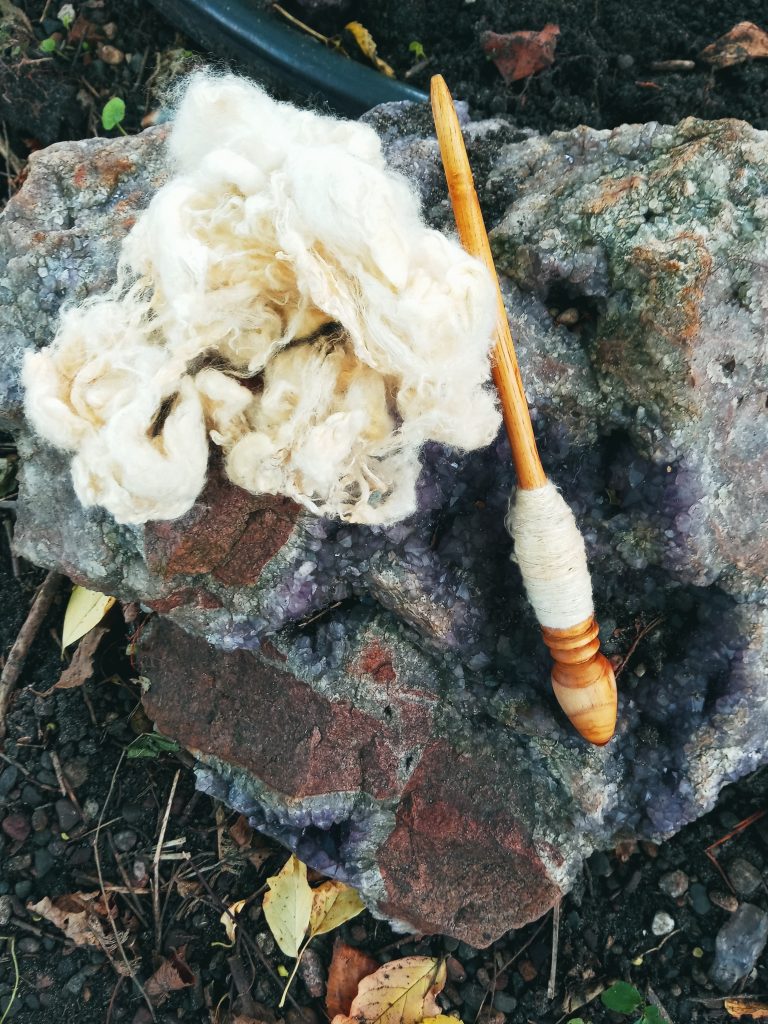
Further Research
It took multiple attempts to get the alkali solution to the proper pH. Different types of wood could influence the pH level, as also the source of water. The question is how people in antiquity knew that the solution was strong enough to degum cocoons. Tradition might have had that a particular type of wood was preferred and that quantities were measured so that there was a known ratio of ash to water, or that there was some way of testing the strength of the solution, possibly by observing colour changes in natural dye solutions (Wood 2020). Further experiments are needed to better understand the degumming process as it was practiced in antiquity.
References
Baro, M. (2020) Instructible: Silk Spinning for Lazy People https://www.instructables.com/id/Silk-spinning-for-lazy-people
Belgiorno, M.R. (2010) Cipro all’inizio dell’Età del Bronzo: Realtà sconosciute della comunità. Gangemi Editore, Rome.
Cao, T., Wang, Y., and Zhang, Y. (2018) “Effect of Strongly Alkaline Electrolyzed Water on Silk Degumming and the Physical Properties of the Fibroin Fiber.” Plos One 8(6): e65654 https://www.ncbi.nlm.nih.gov/pmc/articles/PMC3688822/
Cook M. (2017) Wormspit http://www.wormspit.com/ and http://www.wormspit.com/degumming.htm
Gonzato, F. (2015) Precious cloths & prestige technologies: Textile production from Pyrgos-Mavrorachi in Cypriot Cultural Details: Proceedings of the 10th Annual Meeting of Young Researchers in Cypriot Archaeology, I. Hadjikyriako, M.G.Trentin, Eds. Oxbow Books, Oxford
Gonzato F., A. Lentini (2010) Textiles Quality and Spindle Whorls Type: New data about spinning techniques In Cypriot Middle Bronze Age. International Congress on Archaeological Sciences in the Eastern Mediterranean and the Near East (ICASEMNE), Paphos, Cyprus
Hadjikyriakos, I and M. G. Trentin (2015) Cypriot Cultural Details: Proceedings of the 10th Annual Meeting of Young Researchers in Cypriot Archaeology
Karlitaş, H. (2015) Silkworm-breeding and Silk Cocoon. North Cyprus Monthly Magazine (December) http://www.northcyprusuk.com/egitim-kultur-sanat-tarih/silkworm-breeding-and-silk-cocoon-h2611.html
Kolander C. (1985) A Silk Worker’s Notebook. Interweave Press, Colorado
Konstantinou G. (2016) Biodiversity of Cyprus by NGO Protection of the Natural Heritage and the Biodiversity of Cyprus http://biodiversitycyprus.blogspot.com/2016/05/silkworm-bombyx-mori-linnaeus-1758.html
Lamb, S. (2014). The Practical Spinner’s Guide – Silk. Interweave Press (May 31, 2014)
Luong, T., Dang, T., Ngoc, O., Dinh-Thuy, T., Nguyen, T., Toi, V., Duong, H., and Son, H. (2014) Investigation of the Silk Fiber Extraction Process from the Vietnam Natural Bombyx Mori Silkworm Cocoon 391 BME2014 in Vietnam, IFMBE Proceedings, Springer Verlag.
Panagiotakopoulou, E., Buckland, P.C., Day, P.M., Doumas, C., Sarpaki, A., and Skidmore, P. (1997) A lepidopterous cocoon from Thera and evidence for silk in the Aegean Bronze
Age, Antiquity 71, 420-29.
Whitfield, S. (2018) Silk, Slaves, and Stupas: Material Culture of the Silk Road: Material Culture of the Silk Road. University of California Press
Wood, J. (2020). How to Test pH of Water Without a Kit? Water Filter Cast https://waterfiltercast.com/how-to-test-ph-of-water-without-a-kit/
If you enjoyed this article and would like to support this web page, please consider a small contribution through PayPal, or my Patreon Page https://www.patreon.com/archaeology.
